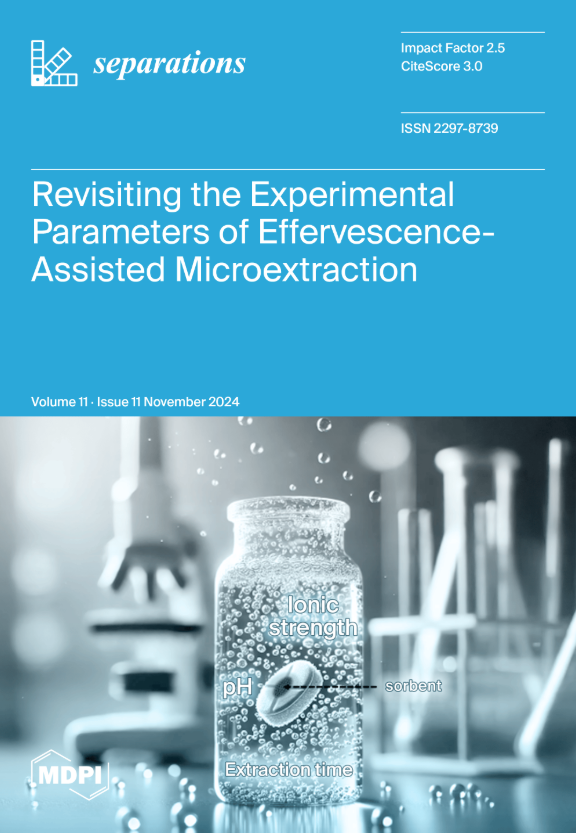金属(IV)磷酸盐和膦酸盐材料的成分分析--陷阱与最佳实践
IF 2.7
4区 工程技术
Q3 CHEMISTRY, ANALYTICAL
引用次数: 0
摘要
金属(IV)磷酸盐和膦酸盐材料越来越多地应用于水净化、异相催化、药物输送和质子交换膜燃料电池。四价金属阳离子与磷酸盐/膦酸盐基团之间的强联系提供了一个独特的自下而上的设计平台,从而产生了化学性质稳定的无机物或混合物。在材料合成之前,可以通过修改磷酸盐/膦酸盐基团来沉积特定任务的理化功能。另一方面,金属中心和含磷连接体之间的高反应性往往会导致获得无序材料(无定形固体或配位聚合物)。所制备材料的化学成分是指导合成方法及其性能的关键参数。这篇叙述性综述着重批判性地总结了探测这些材料成分的传统和先进分析方法。在探究金属(IV)磷酸盐/膦酸盐时,将向读者介绍并指导不同分析技术的进步和限制。本书涵盖了溶液光谱和固态光谱技术,重点是了解含磷分子的数量和连接状态。这些技术包括原子光谱、质谱、核磁共振光谱、基于 X 射线的方法和中子活化分析。本文章由计算机程序翻译,如有差异,请以英文原文为准。
Compositional Analysis of Metal(IV) Phosphate and Phosphonate Materials—Pitfalls and Best Practices
Metal(IV) phosphate and phosphonates materials have increasingly found their applications in water purification, heterogeneous catalysis, drug delivery, and proton-exchange membrane fuel cells. The strong linkage between tetravalent metal cations and phosphate/phosphonate groups offers a unique bottom-up design platform, resulting in chemically stable inorganics or hybrids. Task-specific physiochemical functionalities could be deposited by modifying the phosphate/phosphonate groups before the material synthesis. The high reactivity between the metal centre and the phosphorus-containing linker, on the other hand, often leads to obtaining unordered materials (amorphous solids or coordination polymers). The chemical composition of the prepared materials is a key parameter in guiding the synthetic approach and in governing their performances. This narrative review focuses on critically summarising the traditional and advanced analytical methods for probing the composition of these materials. The reader is introduced to and guided on the advances and restrictions of different analysis techniques when probing metal(IV) phosphates/phosphonates. Both solution-based and solid-state spectroscopic techniques are covered with a focus on understanding the quantity and the linkage status of the phosphorus-containing moieties. These techniques include atomic spectroscopy, mass spectroscopy, nuclear magnetic resonance spectroscopy, X-ray-based methods, and neutron activation analysis.
求助全文
通过发布文献求助,成功后即可免费获取论文全文。
去求助
来源期刊

Separations
Chemistry-Analytical Chemistry
CiteScore
3.00
自引率
15.40%
发文量
342
审稿时长
12 weeks
期刊介绍:
Separations (formerly Chromatography, ISSN 2227-9075, CODEN: CHROBV) provides an advanced forum for separation and purification science and technology in all areas of chemical, biological and physical science. It publishes reviews, regular research papers and communications. Our aim is to encourage scientists to publish their experimental and theoretical results in as much detail as possible. There is no restriction on the length of the papers. The full experimental details must be provided so that the results can be reproduced. There are, in addition, unique features of this journal:
Manuscripts regarding research proposals and research ideas will be particularly welcomed.
Electronic files and software regarding the full details of the calculation and experimental procedure, if unable to be published in a normal way, can be deposited as supplementary material.
Manuscripts concerning summaries and surveys on research cooperation and projects (that are funded by national governments) to give information for a broad field of users.
The scope of the journal includes but is not limited to:
Theory and methodology (theory of separation methods, sample preparation, instrumental and column developments, new separation methodologies, etc.)
Equipment and techniques, novel hyphenated analytical solutions (significantly extended by their combination with spectroscopic methods and in particular, mass spectrometry)
Novel analysis approaches and applications to solve analytical challenges which utilize chromatographic separations as a key step in the overall solution
Computational modelling of separations for the purpose of fundamental understanding and/or chromatographic optimization
 求助内容:
求助内容: 应助结果提醒方式:
应助结果提醒方式:


